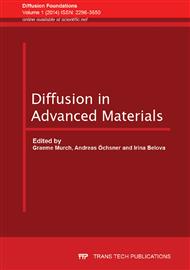[1]
J. Philibert: Atom movement, diffusion and mass transport in solids, Le Edition de Physique, 220 (1991).
Google Scholar
[2]
Y. E. Geguzin: Diffusion Zone (Moscow: Nauka) (1979).
Google Scholar
[3]
A.M. Gusak, T.V. Zaporozhets, J. Phys.: Condens. Matter 21 415303 (2009).
Google Scholar
[4]
D.L. Beke, I.A. Szabó, Z. Erdelyi, G. Opposits: Mater. Sci. Eng. A 4 387 (2004).
Google Scholar
[5]
G. Schmitz, C.B. Ene, C. Nowak: Acta Mater. 57 2673 (2009).
Google Scholar
[6]
Z. Erdélyi: Nanoscale Diffusion and Solid State Reaction in Layered Structures: XRR, XRD, GIXRF, EXAFS, XSW, In: Dao Ming Chua, Huang Fu Toh (ed. ) Synchrotron: Design, Properties and Applications New York: Nova Science Publishers Inc., 2012. pp.115-132.
Google Scholar
[7]
Z. Erdélyi, G. Schmitz: Acta Mater. 60 1807(2012).
Google Scholar
[8]
F. Aldinger: Acta Met. 22, 923 (1974).
Google Scholar
[9]
Y.E. Geguzin, Y. Klinchuk, I. Yu and L.N. Paritskaya: Fiz. Met. Metalloved. (in Russian) 43, 602 (1977).
Google Scholar
[10]
Y. Yin, R.M. Rioux C.K. Erdonmez, S. Hughes, G.A. Somorjai, and A.P. Alivisatos: Science 304 711 (2004).
DOI: 10.1126/science.1096566
Google Scholar
[11]
Y. Yin, C.K. Erdonmez, A. Cabot, S. Hughes and A.P. Alivisatos: Adv. Funct. Mater. 16 1389 (2006).
DOI: 10.1002/adfm.200600256
Google Scholar
[12]
C.M. Wang, D.R. Baer, L.E. Thomas, J.E. Amonette, J. Antony, Y. Qiang and G. Duscher: J. Appl. Phys. 98 09430 (2005).
Google Scholar
[13]
R. Nakamura, J.G. Lee, D. Tokozakura, H. Mori and H. Nakajima: Mater. Lett. 61, 1060 (2007).
Google Scholar
[14]
R. Nakamura, D. Tokozakura, H. Nakajima, J.G. Lee and H. Mori: J. Appl. Phys., 101 074303 (2007).
Google Scholar
[15]
R. Nakamura, J.G. Lee, H. Mori and H. Nakajima: Phil. Mag. 88 257 (2008).
Google Scholar
[16]
H. Nakajima, R. Nakamura: J. of Nano Research, 7, 1 (2009).
Google Scholar
[17]
K.N. Tu and U. Gösele: Appl. Phys. Lett. 86 093111 (2005).
Google Scholar
[18]
A.M. Gusak, T.V. Zaporozhets, K.N. Tu and U. Gösele: Phil. Mag. 85 4445 (2005).
Google Scholar
[19]
I.V. Belova and G.E. Murch: J of Phase Eq. and Diff. 26, 430 (2005).
Google Scholar
[20]
A.V. Evteev, E.V. Levchenko, I.V. Belova and G.E. Murch: Phil. Mag. 87 3787 (2007).
Google Scholar
[21]
R. Nakamura, D. Tokozakura, J.G. Lee, H. Mori and H. Nakajima: Acta Mater. 56 5276 (2008).
Google Scholar
[22]
A.M. Gusak and K.N. Tu: Acta Mater. 57 3367 (2009).
Google Scholar
[23]
A.V. Evteev, E.V. Levchenko, I.V. Belova and G.E. Murch: J. of Nano Research, 7, 11 (2009).
Google Scholar
[24]
A.V. Evteev, E.V. Levchenko, I.V. Belova and G.E. Murch: Phil. Mag. 88, 1524 (2008).
Google Scholar
[25]
G.E. Murch, A.V. Evteev, E.V. Levchenko and I.V. Belova: Diffusion Fundamentals 11, 1 (2009).
Google Scholar
[26]
I. Beszeda, I.A. Szabó and E.G. Gontier-Moya: Appl. Phys. A78 1079 (2004).
Google Scholar
[27]
O.M. Podolyan, T.V. Zaporozhets: Ukr. J. Phys., 2011, 56, 929-939.
Google Scholar
[28]
Gy. Glodán, C. Cserhati, I. Beszeda, D.L. Beke: Appl. Phys. Lett. 97 (2010), 113109-3.
Google Scholar
[29]
Gy. Glodán, C. Cserháti, D.L. Beke: Phil. Mag. 92 (2012)31: 3806-3812.
Google Scholar
[30]
H.J. Fan, M. Knez, R. Scholtz, D. Hesse K. Nirelsch, M. Zacharias, U. Gösele: Nano Lett., 2007, 7, 993-997.
Google Scholar
[31]
H. Mehrer: Diffusion in Solid Metals and Alloys, Landolt Börnstein, New Series III/26, Springer-Verlag, Berlin, (1990).
Google Scholar
[32]
A. Haessner, M. Jurish, W. Lange: Z. Metallkunde, 60 (1969) 219.
Google Scholar


